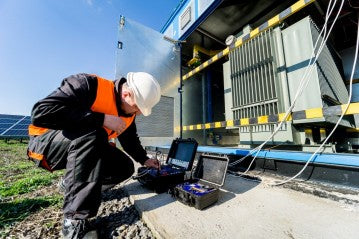
In today's fast-paced world, where sustainable energy solutions are gaining increasing importance, solar energy has emerged as a reliable and eco-friendly option. Solar energy systems often utilize batteries to store electricity for use during times of low sunlight or power outages. As a potential customer considering solar energy products, it is crucial to understand the technical specifications associated with batteries. One such specification is the Ah rating, which stands for amp hours. In this blog post, we will delve into the meaning of Ah on a battery, its significance, and how it relates to battery capacity.
1. What is an Amp?
Before delving into Ah ratings, let's first understand what an amp is. An ampere, commonly referred to as an amp, is the unit of electric current. It measures the rate at which electric charges flow through a circuit. In simpler terms, amps quantify the amount of electricity flowing through a conductor, indicating the strength of an electrical current.
2. What are Amp Hours and What Does Ah Mean in a Battery?
When it comes to batteries, the term "Ah" is an abbreviation for "amp hours." It represents the amount of electrical charge a battery can deliver over a specific period. Essentially, Ah indicates the battery's capacity or the total amount of energy it can store. For example, a battery with a 100Ah rating can theoretically deliver a continuous current of 1 amp for 100 hours, 2 amps for 50 hours, and so on.
3. How Do You Calculate Battery Capacity?
To calculate the battery capacity in Ah, you need to know the current (in amps) and the duration (in hours) over which the battery is expected to discharge. By multiplying the current (amps) by the duration (hours), you arrive at the battery capacity in Ah. For instance, if a device draws a constant current of 0.5 amps and you want it to operate for 10 hours, the required battery capacity would be 5 Ah (0.5A x 10h = 5Ah).
4. What's the Difference Between Amps, Ohms, and Volts?
To better understand Ah ratings, it's important to grasp the distinctions between amps, ohms, and volts. Amps, as mentioned earlier, measure the electric current flowing through a circuit. Ohms, on the other hand, represent electrical resistance, indicating how easily the current flows through a material. Volts measure the electric potential difference or the force that pushes the electric charges through the circuit. These three units are interconnected in Ohm's Law, which states that the current (amps) flowing through a circuit is equal to the voltage (volts) divided by the resistance (ohms).
5. Are AC and DC Amps the Same?
It is worth noting that the amps used to measure current can differ between alternating current (AC) and direct current (DC) systems. In AC circuits, the current continuously changes direction, whereas in DC circuits, it flows in a constant direction. When comparing AC and DC currents, the value of amps refers to the root mean square (RMS) value in AC systems. This value represents the equivalent direct current that would produce the same amount of power in a resistive load. Therefore, AC and DC amps are not directly comparable, as the measurement conventions differ.
6. Common Ah Ratings
When purchasing batteries for solar energy systems, you will come across various Ah ratings, each tailored to specific applications. Common Ah ratings for solar energy products range from small-scale systems, such as portable solar chargers with capacities around 5-10 Ah, to larger setups with batteries rated at 100Ah or higher. The appropriate Ah rating for your solar energy system depends on factors like power consumption, the duration of backup required, and the number of devices to be powered simultaneously.
Conclusion
Understanding the meaning of Ah on a battery is essential for customers interested in purchasing solar energy products. The Ah rating represents the battery's capacity and indicates the amount of electrical charge it can deliver over a specific period. By calculating battery capacity based on the current and duration of use, customers can choose the appropriate Ah rating for their solar energy system. Moreover, comprehending the differences between amps, ohms, and volts provides a foundation for understanding the intricacies of electrical systems. Armed with this knowledge, customers can make informed decisions when selecting batteries for their solar energy needs, ensuring optimal performance and reliable energy storage.
By familiarizing yourself with the technical specifications and concepts related to batteries, you will be better equipped to harness the potential of solar energy and contribute to a greener future.

0 Kommentare